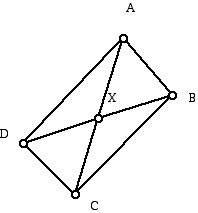
Review Examination I
Geometric Structures, Mathematics 244
prepared by:
Joseph Malkevitch
Department of Mathematics and Computing
York College (CUNY)
Jamaica, New York 11451
Email: malkevitch@york.cuny.edu
1. Draw a diagram of the following (when possible the diagram should be drawn in the plane):
a. A scalene triangle
b. An equilateral triangle
c. An equiangular 4-gon that is not a square
d. An equilateral quadrilateral that is not a square
e. A non-convex, non-self-intersecting 4-gon
f. A trapezoid with three equal sides that is not a rectangle
g. An equiangular hexagon which is not a regular hexagon
h. A self-intersecting regular pentagon
i. An isosceles right triangle
j. An acute angle triangle
k. A parallelogram which is not a rectangle or a rhombus
l. A kite
m. A quadrilateral with exactly two, nonadjacent right angles
n. Draw a graph with 7 vertices and 9 edges
o. Draw an equiangular triangle
p. Draw an isosceles triangle which is not equilateral
q. A non-convex self-intersecting 7 sided polygon
r. Give some examples of 3-dimensional geometrical figures
s. Give some examples of 2-dimensional geometrical figures
t. What is the difference between a ray and a segment?
2. Give precise definitions of the following:
a. Convex set
b. A circle
c. A circular disc
3, a. From the point of view of analytical geometry, what are the points of the Euclidean plane?
b. From the point of view of analytical geometry, what are the lines of the Euclidean plane?
c. From the point of view of analytical geometry, what are the points of the taxicab plane?
4. a. Draw all the polyominoes which consist of 3 or fewer 1x1 cells.
b. Draw two pentominos of different perimeter.
c. Draw three hexaminos of different perimeter.
5. Draw a legal polyomino which is non-convex because it has a "hole."
6. What is the angle sum of the interior angles of a convex 7-gon?
7. a. For each vertex of the pyramid below build over a rectangle find the sum of the face angles at that vertex. (Triangles XAB and XCD are equilateral triangles; AXD and BXC are right isosceles triangles; ABCD is a rectangle.)

b. Compute the defect for each vertex of this polyhedron and determine the defect of the polyhedron.
8. Draw three different nets for a cube.
9. For the graphs below give the number of vertices and edges, as well as the valence (degree) of each vertex. (The valence of a vertex is the number of edges of the graph at that vertex.)
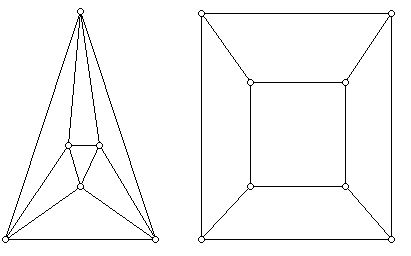
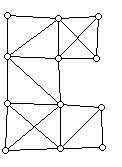
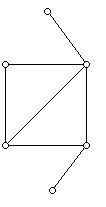
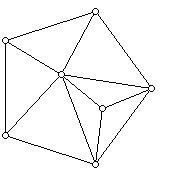
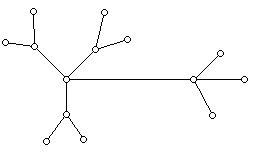
10. How many diagonals are required to triangulate a 43 sided convex polygon? How many diagonals are required to triangulate a simple 31 sided plane polygon? How many triangles does one get in this case?
11. The points and lines below are in the real projective plane, though of as ordered triples of homogeneous coordinate real numbers.
Given:
Triangle: ABC with vertices A = (2, -6), B = (4, 10), C = (-4,8)
a. Write down the Euclidean lengths of the sides of the triangle.
b. Write down the length of the sides of the triangle using taxi cab distance.
b. Write down the equations of the lines forming the sides of the triangle.
c. What condition does the set of points that are equidistant (Euclidean distance) from B and C satisfy?
c. Determine those points in the taxicab plane which are equidistant from B and C.
d. Determine those points in the taxicab plane which are equidistant from (0,0) and (2,2).
e. Sketch those points in the taxicab plane which lie on the taxicab circle centered at (-2.3) and having radius 4.
12. What is the Cayley-Klein Model for having a plane geometry with multiple parallels?
13. a. Let Q be a quadrilateral with vertices A = (0, 0), B= (a, 0), C = (b, c), D = (d, e). What are the coordinates of the midpoints of the four sides? Find the slopes of the 6 lines determined by these 4 points. What do you notice?
b. Can you find choices of a, b, c, e, and e so Q is non-convex?
14. Draw a plane non-convex polygon with 12 sides and which has at least 3 reflex angles? (Remember that a convex vertex is one where the angle between the sides at that vertex is less than 180 degrees, while a reflex angle is one where the angle between the sides at the vertex is more than 180 degrees.)
15. a. Is it possible to define all the terms in a mathematical system?
b. What are the usual undefined terms for a geometry?
16. Give some examples of axioms from Euclidean geometry?
17. Give a precise statement of Playfair's Axiom.
18. Give a precise statement of Euclid's Fifth Postulate.
19. What are the points and lines for the usual geometry on a sphere.
20. Draw three different nets for a cube which has no lid.